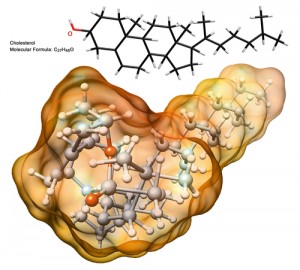 A new study entitled “Discovery of a Class of Endogenous Mammalian Lipids with Anti-Diabetic and Anti-inflammatory Effects” published in the October online issue of Cell reports an unknown class of lipid molecules that carry new possible therapeutics for treating type 2 diabetes.
A new study entitled “Discovery of a Class of Endogenous Mammalian Lipids with Anti-Diabetic and Anti-inflammatory Effects” published in the October online issue of Cell reports an unknown class of lipid molecules that carry new possible therapeutics for treating type 2 diabetes.
Obesity and type 2 diabetes are major epidemics worldwide. In the United States alone, 1.7 million new cases were diagnosed in 2012. Researchers have revealed that a class of lipids — fatty acids — is frequently associated with insulin resistance and glucose intolerance (two characteristic risk factors for type 2 diabetes). However, not all lipids are bad, such as omega-3 fatty acids and palmitoleate, both of which have a positive impact on metabolism.
Now, researchers from Beth Israel Deaconess Medical Center (BIDMC) and the Salk Institute have discovered a new class of lipids — fatty acid hydroxy fatty acids (FAHFAs) — which, unlike omega-3 fatty acids, are produced and broken down in mammals. The authors found this unknown class of lipids in the fat of a diabetes-resistant mouse model developed years before in the laboratory of Barbara Kahn, MD, Vice Chair of the Department of Medicine at BIDMC and the George R. Minot Professor of Medicine at Harvard Medical School.
In her latest research project involving FAHFAs. Dr. Khan, who served as the study’s senior author, noted, “Our adipose-specific GLUT-4 over expressing mouse model [AG4OX] was initially designed after we observed that humans which are insulin-resistant — and therefore, more prone to develop diabetes and metabolic disease — have lower levels of the GLUT-4 glucose transporter molecules in their fat cells. To our surprise, over expression of GLUT-4 in fat was sufficient to increase glucose tolerance and protect the mice against diabetes, even when the animals were obese.”
Previously, the authors noted that AG4OX mice had increased fatty acid levels, however, were sensitive to insulin, and able to control glucose levels in blood. Using mass spectrometry lipidomics technology, the scientists discovered FAHFAs levels were 16- to 18-fold increased in the AG4OX mice when compared to control mice. Further studies showed mice fed with FAHFAs the levels of blood glucose dropped and insulin increased, thus revealing the potential of FAHFAs to treat type 2 diabetes.
Alan Saghatelian, Salk professor in the Clayton Foundation Laboratories for Peptide Biology and second senior author, commented, “Once we had the molecular formula from our lipidomics data, we knew that these lipids belonged to a novel family, and we were then able to use tandem mass spectrometry [MS/MS] and chemical synthesis to identify their structures. Through this approach, they discovered that the molecules consisted of a hydroxyl fatty acid and fatty acid that were joined by an ester bond. I’ve been conducting these analyses for more than a decade, and FAHFA is one of only two new classes of lipids that we’ve uncovered. This is a rare discovery.”
To understand the clinical relevance of their findings, the authors measured FAHFAs levels in humans insulin-resistant. Here FAHFAs were found to be lower in both plasma and fat when compared to healthy controls (those with normal levels of insulin sensitivity), thus hinting to the relevance of these molecules to develop diabetes.
Kahn commented, “The discovery of FAHFAs provides important new insights underlying metabolic and inflammatory diseases, and, of critical importance, offers viable new treatment avenues that we hope to be able to test in clinical trials. This is of critical importance as rates of obesity and type 2 diabetes remains at epidemic proportions worldwide.”


